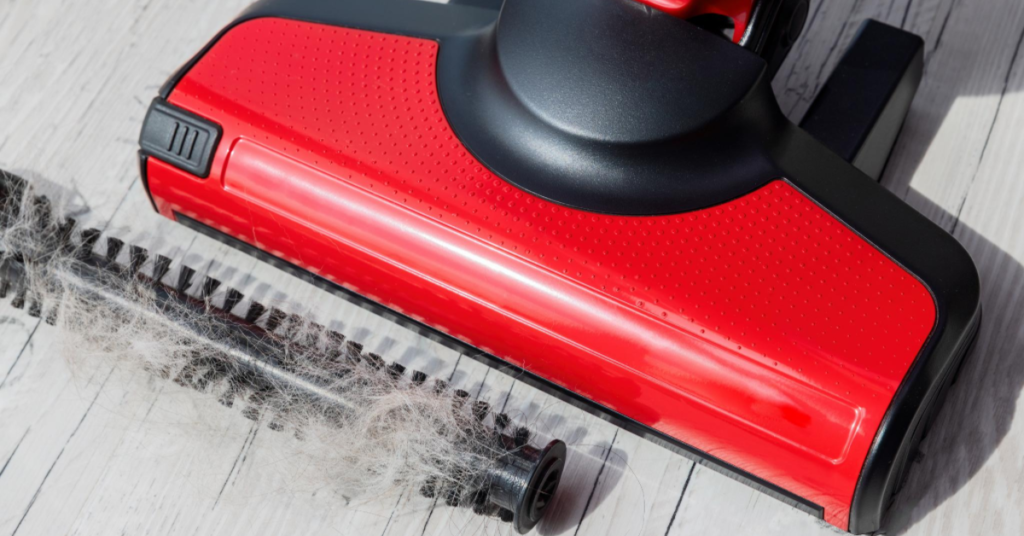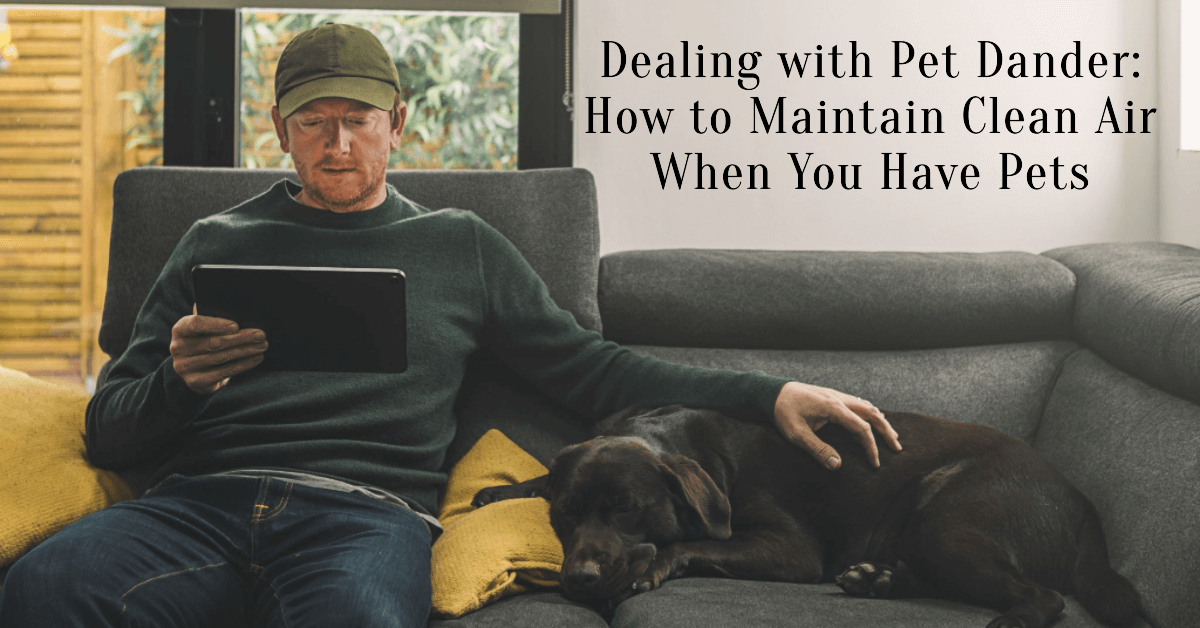Dealing with pet dander is a common challenge for many households, especially if someone in the family has allergies or asthma. The quest for maintaining clean, fresh air while cherishing the presence of your pets is the heart of our journey in this article.
Pet dander, comprised of tiny, often microscopic, flecks of skin shed by cats, dogs, and other animals with fur or feathers, is a potent allergen that can trigger sneezing, sniffles, and other discomforts. Despite the challenges it poses, you don’t need to choose between your pets and clean air.
In this comprehensive guide, we’ll go deep into undersatanding pet dander, exploring its origins and the health risks it carries. You’ll discover effective ways to manage and reduce pets dander in your home, ensuring a harmonious and healthy coexistence between your four-legged companions and your loved ones. So, let’s embark on this journey to create a living environment where the warmth of your pets’ presence fills the air without compromising its cleanliness.
Understanding Pet Dander
What is pet dander?
Pet dander consists of tiny, even microscopic, flecks of skin shed by cats, dogs, rodents, birds, and other animals with fur or feathers. These minuscule flecks can cause reactions in people who are specifically allergic to these triggers. While pet hair itself is not an allergen, it can collect dander, along with other allergens like pollen, dust, and mold.

The biology of dander production
Pet dander is produced when animals shed skin cells. Unlike humans who shed skin continuously, animals like cats and dogs shed skin cells in smaller particles that become airborne. These particles can linger in your home for a long time, especially in areas where your pets spend the most time.
Common sources of pet dander
It isn’t just limited to skin cells. It can also be found in an animal’s saliva and urine. When your pet grooms itself, allergen proteins in their saliva become attached to the fur. When these allergen-coated fur particles become airborne, they can be inhaled and lead to allergic reactions.
| Source | Potential Dander Contribution |
|---|---|
| Cats | High |
| Dogs | High |
| Birds | Moderate |
| Small mammals (e.g., hamsters, gerbils) | Low |
| Reptiles | Low |
Health Risks of Pet Dander
Allergic reactions
For individuals with pet dander allergies, exposure to these tiny particles can lead to various allergic reactions. Common symptoms include sneezing, runny or stuffy nose, itchy or watery eyes, and skin rashes. These symptoms can range from mild to severe, and they can significantly affect one’s quality of life.

Asthma triggers
For those with asthma, pet dander is a well-known trigger. Inhaling pet allergens can cause asthma symptoms to worsen. These symptoms may include coughing, wheezing, shortness of breath, and chest tightness. It’s crucial for individuals with asthma to take steps to reduce dander in their homes.
Managing pet dander allergies
Living with pet allergies doesn’t mean you have to part ways with your beloved pets. There are various strategies and interventions to manage pet dander and reduce its impact on your health. From grooming routines to home cleaning practices, you can significantly improve your living environment.
Recognizing the Pet Dander Problem
Signs of pet dander in your home
If you suspect that pet dander is causing allergic reactions, several signs may be present in your home. These include excessive sneezing or coughing, itchy or watery eyes, and an increase in asthma symptoms if you have asthma. Additionally, you may find that your symptoms worsen when you’re in close proximity to your pets or in areas where they spend a lot of time.
Allergy symptoms and their triggers
It’s essential to differentiate between pet dander allergies and other allergies. Allergic reactions to it can often be confused with allergies to pollen or dust mites. Understanding the specific triggers for your allergies can help you implement more targeted strategies for relief.

Identifying pet dander hotspots
Some areas in your home are more likely to collect and harbor pet dander. Places where your pets sleep or rest, such as their bedding or favorite furniture, are common hotspots. Identifying these areas will help you focus your cleaning and allergen reduction efforts.
Reducing Pet Dander in Your Home
Grooming and pet care tips
Regular grooming is one of the most effective ways to Pet dander control. Brushing your pets outdoors can help remove loose fur and dander before it has a chance to settle in your home. Additionally, bathing your pets can further reduce allergen levels. Consult with your veterinarian for guidance on the best grooming practices for your specific pets.
Cleaning routines for pet owners
Pet owners should establish a consistent cleaning routine to keep pet dander at bay. This routine should include vacuuming your home using a vacuum cleaner equipped with a high-efficiency particulate air (HEPA) filter. Cleaning surfaces, washing pet bedding, and using air purifiers are also essential components of a successful cleaning routine.

Allergen-resistant materials and furnishings
Choosing allergen-resistant materials for your home can make a significant difference. Look for furniture and flooring options that are easy to clean and less likely to trap pet dander. Allergen-resistant covers for pillows, mattresses, and furniture can also be highly effective in reducing allergen exposure.
Maintaining a Dander-Free Home
HEPA filters and air purifiers
High-efficiency particulate air (HEPA) filters and air purifiers are valuable tools for removing pet dander and other allergens from the air. These devices can be particularly helpful in bedrooms and other areas where you spend a lot of time.
Vacuum cleaners for pet owners
Investing in a vacuum cleaner designed for pet owners can make a world of difference. These vacuums are equipped with HEPA filters and are specially designed to effectively remove pet dander and fur from floors and carpets.
Pet-free zones and managing allergen exposure
Creating pet-free zones in your home can provide allergy sufferers with safe havens. Bedrooms are often the best place to start. Ensure that your pets are not allowed in the bedrooms, so you have an area where you can enjoy a dander-free environment and a good night’s sleep.
The Role of Diet in Pet Dander Control
Dietary changes for allergy-prone pets
Believe it or not, your pet’s diet can influence the amount of dander they produce. Consult with your veterinarian about dietary changes that may help reduce the allergenic proteins present in your pet’s skin and saliva.
Pet dander control through nutrition
There are pet foods available that are specifically formulated to support skin and coat health, potentially reducing the amount of dander your pet sheds. These foods often contain high levels of omega-3 fatty acids and other nutrients that promote healthy skin.
Consulting with a veterinarian
Your veterinarian is an invaluable resource in your efforts to manage pet dander. They can provide guidance on dietary changes, grooming, and other strategies to minimize dander production and allergen exposure.
Building Allergen-Free Pet Spaces
Pet dander-free sleeping areas
Designating specific areas in your home as pet dander-free zones is an effective way to reduce allergen exposure. In particular, focus on keeping your bedroom free of it to ensure a good night’s sleep, free from allergy symptoms.
Play areas for pets and children
If you have children and pets, create designated play areas where both can enjoy each other’s company without worrying about allergen exposure. These areas should be cleaned and maintained regularly to minimize dander buildup.
Cleaning strategies for pet spaces
Regular cleaning of pet spaces is essential. Wash pet bedding, vacuum these areas, and use allergen-resistant covers when possible. Keeping these spaces clean can significantly reduce allergen exposure.
Managing Allergies While Enjoying Your Pet
Coping with allergies to your beloved pet
Living with a pet you’re allergic to is possible with the right strategies. If you’re committed to making it work, you can create a living environment that accommodates your allergies while still enjoying your pet’s companionship.
Medications and allergy treatments
Consult with an allergist or immunologist to explore allergy medications and treatments. These professionals can provide personalized recommendations for managing your specific allergies, including those related to pet dander.
Balancing pet ownership and allergies
It’s all about balance. By following the strategies outlined in this guide and consulting with healthcare professionals, you can balance pet ownership and allergies. With the right approach, you can enjoy the company of your pets without sacrificing your health and well-being.
Pet Dander and Children
Childhood allergies to pets
If you have children, it’s crucial to be aware of potential allergies to pets. Childhood exposure to pet dander can lead to allergies or asthma. Early recognition and management are key to protecting your child’s health.
Minimizing allergen exposure for kids
Create allergen-safe zones in your home where your children can play without excessive exposure to pet dander. Implementing the strategies mentioned in this guide will help create a healthier living environment for your kids.
Encouraging responsible pet ownership
Teach your children about responsible pet ownership. This includes proper handwashing after handling pets, avoiding pet dander exposure zones, and participating in pet care routines that minimize allergen exposure.
Keeping Pet Dander in Check
Weekly cleaning routines
Maintain a consistent cleaning routine to keep pet dander in check. Regular vacuuming, dusting, and cleaning surfaces will significantly reduce allergen levels in your home.
Regular pet grooming practices
Grooming your pets regularly, especially brushing their fur, can be a game-changer in your battle against pet dander. Outdoor grooming is ideal to prevent allergens from settling indoors.
Combating seasonal changes in pet dander
Be aware that pet dander levels can vary with the seasons. During shedding seasons, implement more frequent grooming and cleaning routines to manage increased allergen production.
| Area or Activity | Recommended Cleaning/Grooming Frequency |
|---|---|
| Pet bedding | Weekly |
| Vacuuming | 1-2 times a week |
| Pet grooming | As needed, especially during shedding |
| Pet-free zones | Regularly maintain cleanliness |
| HVAC system | Schedule professional cleaning and maintenance |
The Positive Side of Pet Ownership
Emotional benefits of pets
Despite the challenges of pet dander allergies, it’s essential to remember the profound emotional benefits of pet ownership. The companionship, love, and joy that pets bring to our lives are immeasurable and can significantly improve our overall well-being.
Responsible pet care
Being a responsible pet owner involves providing love, care, and proper maintenance for your pets. While managing allergies is important, it’s equally crucial to ensure your pets lead happy, healthy lives.
Finding joy in pet companionship
For many, the joy of pet companionship far outweighs the challenges of allergies. With dedication and the right strategies, you can experience the full joy that comes from sharing your life with your beloved pets.
Allergen-Free Homes with Pets
Pet-friendly home design
Creating a pet-friendly home design is about making your living space comfortable for both you and your pets. It involves selecting allergen-resistant materials, choosing pet-safe furnishings, and establishing pet-friendly zones in your home.
Allergen-sensitive home improvements
Consider allergen-sensitive home improvements like adding hard flooring instead of carpet, using washable rugs, and selecting furniture that’s easy to clean. These changes can help reduce allergen exposure in your home.
Creating allergen-free zones
Designate allergen-free zones in your home, such as your bedroom or a child’s play area. These zones should be maintained with the highest level of cleanliness to minimize allergen exposure.
Technology for Managing Pet Dander
Air purifiers and filtration systems
High-quality air purifiers equipped with HEPA filters can be a game-changer for allergy sufferers. These devices effectively remove pet dander and other allergens from the air, providing cleaner and healthier air quality inside home.
Innovations in pet dander control
Ongoing research and innovations are leading to better ways to Pet dander control. Stay updated on the latest developments in pets dander management, as new technologies and products continue to emerge.
Smart home solutions for pet owners
Smart home technology can assist pet owners in managing allergens. From smart air purifiers to sensors that monitor indoor air quality, these solutions can help you maintain cleaner and healthier air while living with pets.
Conclusion
Recap of pet dander and its impact on health
Pet dander can pose challenges for those with allergies, but with the right strategies, its impact on health can be minimized. By following the advice in this guide, you can continue to enjoy the company of your pets while keeping allergy symptoms at bay.
Balancing pet ownership and allergy management
Successfully managing pet dander allergies involves finding the right balance between pet ownership and allergy control. With proper planning, maintenance, and a commitment to responsible pet care, you can lead a happy and healthy life alongside your beloved pets.
Promoting harmonious living with pets for allergy sufferers
Ultimately, pet ownership and allergy management can go hand in hand. By promoting harmonious living with your pets, you can experience the full joy of companionship while maintaining clean air and good health.
FAQ
How do you get rid of pet dander?
To reduce pet dander in your home:Bathe and groom your pet regularly.
Vacuum with a HEPA filter to capture dander.
Wash your pet’s bedding and toys frequently.
Use an air purifier with a HEPA filter.
Keep your home well-ventilated and maintain humidity.
Consider pet-free zones in your home.
Is pet dander a common allergy?
Yes, pets dander is a common allergen. Many people are allergic to proteins in pets dander, leading to allergy symptoms such as sneezing, runny nose, itchy eyes, and in some cases, asthma exacerbation.
Does vacuuming get rid of pet dander?
Vacuuming with a high-efficiency particulate air (HEPA) filter can help reduce pets dander in your home. It captures and removes dander from carpets and upholstery. However, it’s important to vacuum regularly for the best results.
Does pet dander go away?
Pets dander does not disappear completely but can be managed. With proper cleaning, grooming, and using air purifiers with HEPA filters, you can significantly reduce its presence in your home.
Why am I suddenly allergic to pet dander?
Developing allergies to pet dander, even if you weren’t previously allergic, can occur due to various factors. Exposure to pets, changes in your immune system, or new sensitivities are some potential reasons. Allergies can develop over time.
What causes excessive pet dander?
Excessive pets dander can result from factors such as an unclean pet, poor ventilation, high humidity, or a large number of shedding animals in your home. It can also be influenced by the breed of your pet, as some produce more dander than others.
How long does pet dander stay airborne?
Pets dander can stay airborne for extended periods, especially in well-ventilated spaces. It may take hours or even days to settle. Using air purifiers with HEPA filters can help reduce airborne dander over time.
What does a pet dander rash look like?
A rash due to pet dander allergy may appear as red, itchy, raised bumps on the skin. It can resemble other allergic skin reactions and often occurs in areas that have come into contact with the allergen, like hands or arms after touching a pet.
Can you become allergic to pet dander later in life?
Yes, it is possible to develop allergies to pet dander later in life. Allergies can develop or manifest at any age due to changing sensitivities or prolonged exposure to allergens.
DheerajSonwane is a dedicated writer with expertise in air purification technologies. He focuses on providing well-researched content to help readers improve indoor air quality in homes and businesses. As the lead writer at AirPurifierMaster.com, Dheeraj offers practical advice his insightful reviews guide individuals in choosing the best air purifiers for their needs.


1 thought on “Pet Dander: How to Maintain Clean Air When You Have Pets”